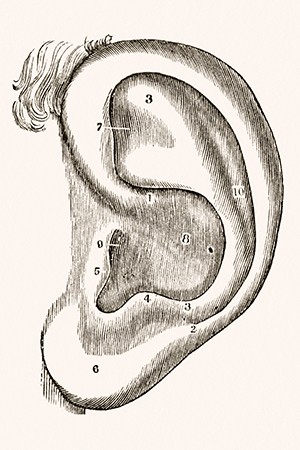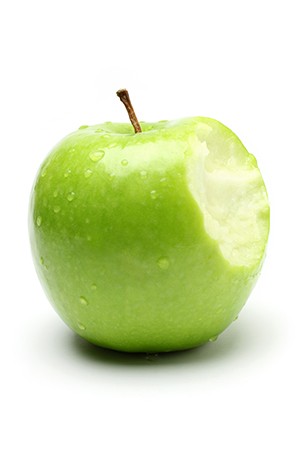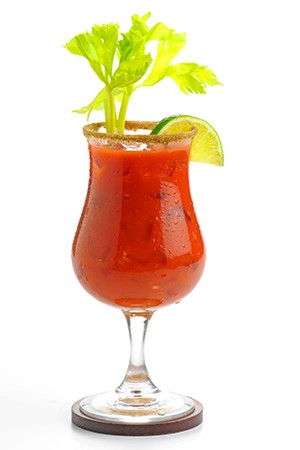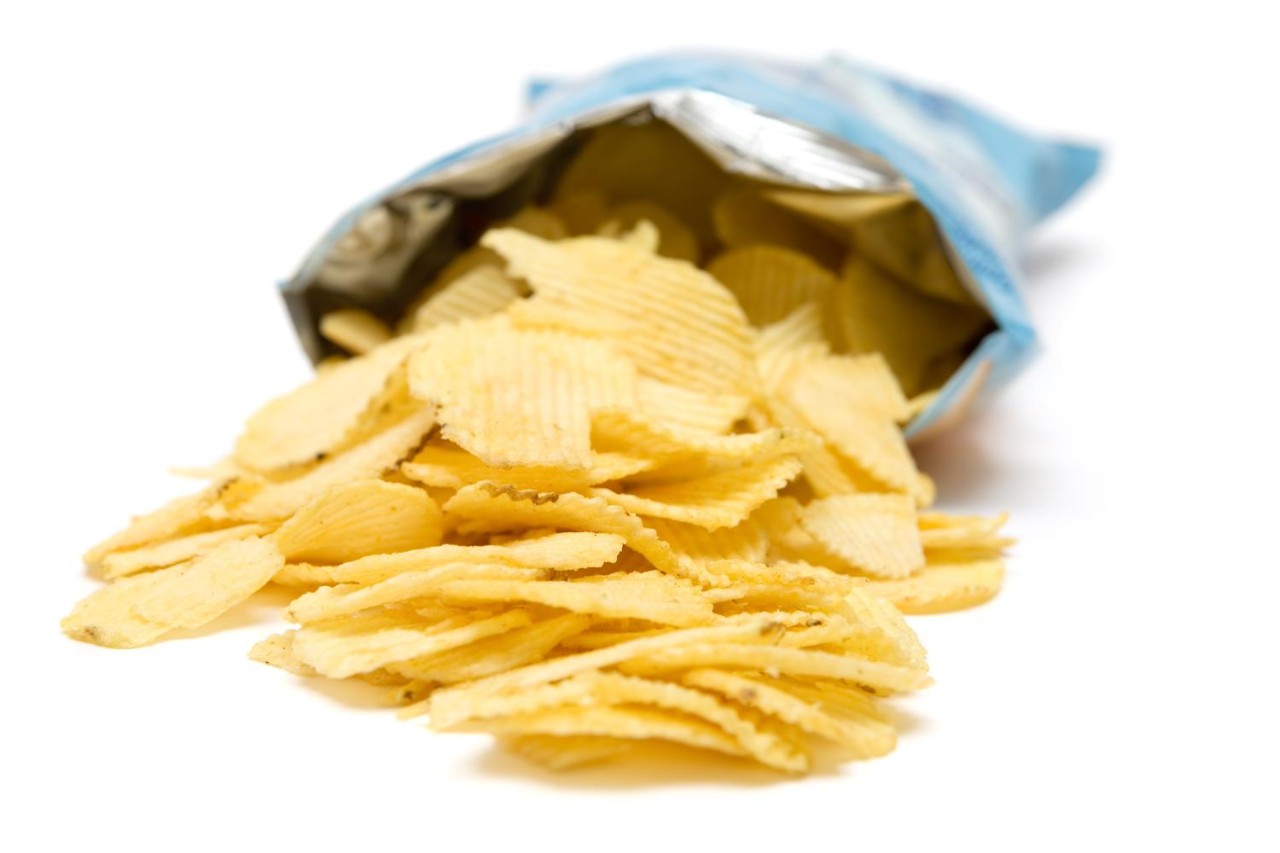(Image above: Creative Commons. Images below: Getty Images/iStockphoto)
The very first life forms on this planet had what we might call a sense of taste—the ability to recognize chemicals in their environment so as to know whether a tidbit would be nutritious or quite the opposite. Taste and smell—the chemical senses—were the first senses to evolve. And taste is everywhere. Moths have taste receptors on their wings. Flies have taste receptors on their knees. Tarantulas taste with their feet. Octopuses taste with their whole body—even their eyelids. We humans have taste receptors all over us as well.
We have taste receptors in our pancreas, liver, and—if you’re a man—testicles. We have taste receptors in our lungs that, when we inhale something noxious, send a signal to the brain to make us cough, so as to expel what shouldn’t be in there. We have taste receptors in our nose that help fight infections, and taste receptors in our gut that influence our perception of food. The taste receptors in our gut also tell the brain whether we should keep eating that ice cream sundae or cheeseburger, and when to stop, and it is believed that disturbances in the signaling pathways of these receptors play a role in the development of diet-induced illnesses, from irritable bowel syndrome to diabetes. But only the taste receptors located inside the 5,000 to 10,000 taste buds on the tongue and, what may come as a surprise, taste buds that are located on the roof of the mouth and in the throat are hooked up to the cortex in the brain that gives us the perception of what we call taste. We can’t tell how sour an apple is with our liver.

There are many misconceptions about taste. For one, not all animals experience the same sensations we do. Cats, from Fluffy the house pet to Cecil the lion, can’t taste sweet. Whales and dolphins only taste salt. Moreover, the notion that we perceive salty, sour, sweet, and bitter on different parts of the tongue is wrong—a holdover from a flawed translation of a fuzzy account by a German graduate student in 1901. Virginia Collins, a researcher at the University of Pittsburgh, determined in 1974 that all tastes can be detected anywhere on the tongue—except, as it turns out, along the center line, which is “taste blind.”
And here’s a piece of taste advice: If you experience strange or unpleasant taste sensations, in addition to seeing a dentist you might want to have your hearing checked.
There is a famous Michelin three-star restaurant in Bray, England, called the Fat Duck. The Fat Duck is in a class of restaurants that practice the art of molecular gastronomy. At the frontier of epicurean adventures, molecular gastronomy investigates the chemical and physical transformations of ingredients that occur in cooking and exploits these physical manipulations along with artistic, technical, and environmental strategies to subvert diners’ expectations and startle their senses, in dishes with names such as “sea scallop, coffee, cauliflower, orange.”
The Fat Duck introduced a dish called Sound of the Sea that is served along with an iPod hidden in a conch shell, with trailing earbuds that one is instructed to utilize while eating. The iPod plays the sound of waves lapping on a shore with a seagull squawking overhead, and the dish looks like a sandy beach that kelp and shells have washed over. Apart from the iPod garnish, everything in this elaborate concoction is edible. Among its ingredients you will find ground ice-cream cone, tapioca, seaweed, oysters, clams, sea urchin, miso oil, and vermouth.
Although not all molecular gastronomy experiments are as pleasing or exciting as their chefs intend them to be, in the case of Sound of the Sea, which the celebrity chef Heston Blumenthal brought out nearly two decades ago, the intellectual effort elevates the sensory experience into something profound when the iPod clicks into action.

Charles Spence, the acclaimed sensory psychologist at Oxford University, has discovered that what we hear directly affects our perception of what we are tasting. In a recent experiment, Spence and his students had people eat toffee, also made by the Fat Duck restaurant, made up of sugar, butter, syrup, treacle (molasses with a slightly bitter bite) and a little salt while listening to one of two soundscapes. One was composed of very low-pitched notes played by brass instruments, while the other was synthesized from high-pitched notes made mainly by a piano. While seated in a darkened booth—so that they couldn’t see clearly—the participants were given two identical pieces of toffee. They put on their headphones and tasted one piece while the high-pitched melody played and the other piece while the low-pitched melody played, rating how sweet and bitter they thought each tasted. Even though the two pieces were identical, when people heard the high-pitched soundtrack they rated the toffee as sweeter and when they heard the low-pitched soundtrack they rated it as more bitter.
This isn’t just an abstract effect that happens in a psychology laboratory. Spence took his test to the streets, teaming up with culinary artist Caroline Hobkinson during her month in residence at the experimental London restaurant House of Wolf (since closed). In October 2012 you could order the “sonic cake pop” for dessert—a nugget of bittersweet toffee covered in a chocolate that came with printed instructions to dial a number on your cellphone. When you called, an operator prompted you to press 1 for sweet or 2 for bitter. If you pressed 1 you heard a twinkling high-pitched melody; if you pressed 2 you heard deep, sonorous tones. Try this yourself with a piece of dark chocolate or even a cup of coffee, using the soundtracks at soundcloud.com/condiment-junkie. When you hear the high-pitched soundtrack labeled “sweetness” it should feel like your brain has hijacked your taste buds in a sweet crescendo, while the low-pitched soundtrack (“Taste 1”) should turn what you have in your mouth to a bitter chord.
Spence calls these multisensory linkages “sensation transference,” a term borrowed from Louis Cheskin, a marketing innovator of the 20th century who observed how consumers’ perception of a product was based on both the product and the sensory input associated with it. For example, the green color of a 7 Up can makes the soda taste more lemon-limey. Our brain uses a cue from one sense, such as hearing or vision, to inform another sense, such as taste. Ben & Jerry’s, the legendary ice cream emporium, is apparently considering creating a set of sonic flavors with QR codes on their containers that you can scan with your cellphone to bring up flavor-enhancing tones. The sounds of Cherry Garcia?
But why do high-frequency notes enhance sweetness and low-pitched notes enhance bitterness? One explanation is that the perceptual change is based on psychological associations and conceptual correspondences that we have learned through experience—as with colors and shapes. Desserts are typically round, so round shapes make food seem sweeter, and when we hear the jingling song of the ice cream truck we know that a sweet treat is around the corner. Indeed, the fact that our eating history overlaps with our sensory perceptions is why bacon-and-egg ice cream—yes, for real—tastes more of bacon when you can hear bacon sizzling in the background, and the Fat Duck’s Sound of the Sea tastes fresher and more pleasing when diners eat it to the sound of lapping waves.
Another explanation for the taste-sound connection is that it is an example of mild synesthesia. Synesthesia is the crossing over of one sensory experience into another. About 4 percent of the population possess an extreme level of this condition and vividly experience specific tastes, or colors, or sounds, or tactile sensations when another sense is activated. In the case of “MW,” who was described in detail by Richard Cytowic in his 1993 book, The Man Who Tasted Shapes, chicken tasted “pointy.” Sounds are often triggers for synesthetes. At a recent music technology competition in the U.K. that lasted for 24 hours, the composer LJ Rich played different tastes on the piano at about four in the morning to improve her fellow musicians’ mood, and then played the “taste of eggs” at breakfast. It wasn’t until that morning’s improv that Rich discovered her musical riffs weren’t understood by all, even though synesthesia is more common among musical prodigies than the rest of the population. New research has revealed that experiencing synesthesia and having absolute pitch—the ability to identify or recreate any musical note without a reference tone—are genetically linked.

Another possibility is that the synergy between our senses is due to emotional associations. Low sounds tend to convey negative messages and emotions and high frequencies have positive connotations. As anyone who has listened to Prokofiev’s symphony Peter and the Wolf will remember, the reprimanding grandfather was represented by the bassoon while the innocent bird was a flute. The enhancements that occur between sound and taste may also be influenced by more personal memories. Some customers at the Fat Duck were reduced to tears while eating the Sound of the Sea because of the intense recollections that the aural and oral sensations evoked.
The most intriguing explanation for why specific sounds change our perception of taste points to a correspondence between various sounds and the way the mouth moves when we experience certain tastes. The facial expressions we make when we taste something bitter are innate, and automatically either instigate the expulsion of what we have in our mouth, or prevent anything else from getting in. In both the tongue-out bleh-face and the pursed-lips grimace, the tongue is pressed down. If you were to make a noise with your tongue pressed down it would be a low-pitched sound (e.g., bleh). By contrast, when you are making the instinctive smiling face produced by a sweet taste the tongue presses against the upper palate, and a noise made with the tongue pressed against the upper palate is high-pitched. In other words, there is an instinctive and biologically meaningful connection between making low-pitched sounds and bitter taste and making high-pitched sounds and sweet taste.
Most likely a combination of the inner wisdom in all of these theories explains why each of us at different times experiences a synergy between the sounds we hear and the tastes we’re tasting.
An obvious but often overlooked category of sound is the noises we ourselves make while eating. Charles Spence and his colleagues have also investigated this particular sound-taste integration. In their experiment, participants wore a microphone positioned close to their mouth and headphones over their ears while they ate Pringles potato chips. (Pringles were chosen because every Pringles chip looks and feels identical.) With each chip, participants were told to take a bite and spit, and then rate the chip for various qualities. What they were not told was that while they bit into the chips the sound of their crunches, which they heard through their headphones, was being manipulated variously to be louder or softer, or to accentuate the higher- or lower-pitched frequencies. These modulations considerably altered how people rated the chips. When their crunches were made louder or when the higher frequencies were accentuated, the chips were liked better and rated as crispier and fresher; when the volume was lower or the high frequencies were dampened, the chips were rated as softer and staler. After the experiment was over, three-quarters of participants spontaneously commented that the “staler” chips must have come from containers past their expiration date or that had been left open. In fact, all the chips were from the same unspoiled canisters and were virtually identical.
Another way that sound influences our appreciation of what we’re about to dig into is the noise that the packaging makes. Here Pringles don’t do as well as Lay’s Classic. When people hear the pop of a canister they rate the chips inside as less crispy than if they hear the crackle of a bag being torn open. But beware: Very loud bag noise can be a big turnoff. In 2010, the snack food giant Frito-Lay thought it would gain consumer appeal among environmentalists by introducing a 100 percent compostable bag for SunChips, the company’s “healthy” snack. Based on what they already knew about crinkling bags making a crispier impression, they created a new “green”—but in this case, overly mean—bag. The sound that this new, compostable SunChips bag made when it was crinkled, let alone ripped apart, was off the charts.

J. Scot Heathman, an Air Force pilot and vlogger, performed an online test. Opening the new bag of SunChips reached a noise level of 95 decibels. A jackhammer from 50 feet away is 95 decibels; anything above 90 decibels is considered damaging to one’s hearing. A Frito-Lay spokesperson explained that the noise was because the new biodegradable polymers had a glass-like quality. In other words, crinkling the bag was like listening to breaking glass. In response to this innovation, a Facebook group called “Sorry but I can’t hear you over this SunChips bag” went viral. Frito-Lay engineers redesigned the bag. It is no longer totally biodegradable, but opening it is down to a gentle rustle—a mere 70 decibels, the same as the original SunChips bag.
It isn’t just crunching in our mouth or bag noises that makes chips seem crispier. Loud noise in general raises the crispometer. Researchers at the University of Manchester in the U.K., in partnership with scientists at the fragrance and flavor manufacturing empire Unilever—which owns Ben & Jerry’s, Nestea, and Hellman’s, among many other brands—conducted an experiment in which participants wearing headphones heard white noise at either a quiet volume (45–55 decibels, similar to the background hum of a library) or a loud volume (75–85 decibels, the equivalent of standing beside a food processor), while simultaneously snacking on various hard or soft, sweet or savory foods, such as sugar cookies and pancakes, or potato chips and cheese. Both hard and soft foods were rated as having more taste when the white noise was quiet: Pancakes were sweeter and chips were saltier. By contrast, hard foods like rice cakes were rated as substantially crunchier when the noise was loud. Therefore, loud noise makes food seem crispier, but surprisingly, it also makes it more tasteless.
The dampening effect of loud noise on taste may partly explain why airplane food is never very good, even in first class. The ambient rumble inside an airplane cabin is typically about 75–85 decibels. This noise volume reduces the saltiness and sweetness of whatever you’re eating, on top of which the low air pressure of high-altitude flying constricts your nasal passages, so less aroma flows through them. Take solace in knowing that the “grilled salmon on cedar plank” that your first-class fellow travelers are being served won’t be that much better than the “chicken surprise” you’re getting in economy, since everyone is in the same compromised taste state. However, if you order a Bloody Mary or its virgin counterpart during a mile-high excursion you will be pleased.
Anyone who sells or serves juices knows that fruit juices are more popular than vegetable juices, but in 2010 the German airline Lufthansa noticed that passengers were consuming as much tomato juice as beer. To figure out why, Lufthansa commissioned a study with LSG Sky Chefs—the largest in-flight catering company in the world—to simulate in-flight airplane meals, and it was discovered that low cabin pressure enhanced the taste of tomato juice. But if loud noise reduces salty taste, why did this happen—after all, isn’t tomato juice salty?
Robin Dando, a rising star in food and sensory science at Cornell University, along with his student Kimberly Yan, tested what happens to taste perception under different noise conditions. Participants ranging in age from 18 to 55 wore headphones that played either a recording of airplane cabin noise at 85 decibels or the sound of silence, and rated the taste of weak, medium, and high concentrations of salty, sour, sweet, bitter, and umami solutions. (Umami, literally “deliciousness” in Japanese, comes from the amino acid glutamate, a building block of proteins and a key ingredient of the flavor enhancer monosodium glutamate, or MSG.)
Sound had no effect on bitter taste. Sweet tasted conspicuously less sweet in loud noise, and a similar trend was noted for salty and sour. But, surprisingly, umami was perceived as tasting much more intense when participants heard loud noise compared to silence, and the higher the concentration of umami the stronger it was rated to be when loud noise played. Tomatoes contain a lot of glutamate and therefore have a high umami profile—they seem salty mainly because of a similarity between salty and umami taste. This is the explanation for why on a recent flight my husband turned to me after ordering a Bloody Mary and exclaimed, “These always taste so good on airplanes!” To which I shouted back, “It’s because it’s so loud in here.”
The combined perturbations of different tastes during loud noise is one reason why airplane food is generally given two thumbs down. If salty and sweet weaken, and bitter remains strong, the grapefruits and fruit cocktail for breakfast and chicken with broccoli for dinner will be downers. However, if airlines were to change their menus to focus on umami-rich foods, such as tomatoes, parmesan cheese, mushrooms, and bacon, long-haul passengers in every class would be a lot happier. Here’s hoping that Mediterranean stuffed mushrooms will be coming to in-flight dinners soon.
You may now be wondering, Why is it that the booming blare of an airplane engine changes the ways cocktails and cupcakes taste? The answer illustrates the interplay between our senses and what goes on in our head—literally.
Our sense of taste is innervated by three cranial nerves: the chorda tympani branch of the facial nerve, the glossopharyngeal nerve, and the vagus nerve. The chorda tympani carries taste information from the front part of the tongue (the part you can stick out) to the brain, and when it exits the mouth it crosses the tympanic membrane of the middle ear. That is, a primary taste nerve crosses through the ear before it gets to the brain. Recent research in mice suggests that loud noises cause a temporary disturbance to the chorda tympani as it passes through the middle ear such that signals relaying sweet and salty sensations become weakened and umami sensations become heightened.
The fact that so many nerves are involved in taste is the reason why it is extremely difficult to completely lose the ability to distinguish between salty, sour, and sweet. However, mild taste-nerve damage is more common than most people realize. Individuals who suffered multiple ear infections in childhood often have distortions of taste due to damage to the chorda tympani. Paradoxically, chorda tympani damage sometimes causes increases in taste sensations because it can release the normal inhibition of taste perception that is there. Having your tonsils removed—depending on the anatomy of your throat—runs the risk of injuring the glossopharyngeal nerve, which can also lead to taste perturbations.
But don’t worry too much if you had lots of ear infections as a child or a tonsillectomy; there is a great deal of variability in both the damage and the disturbances in taste that are reported. When we eat, a complex dance takes place between the food and drink, the background sounds, the noises in our mouth, the sights before our eyes, the scents we breathe in and breathe out, even the heft of our utensils, all of which influence the experience of our meal.
Rachel Herz teaches “Sensory Processes and the Psychology of Food” in the psychology department at Boston College and is on the faculty at Brown University. Her essay is drawn and adapted from her new book, Why You Eat What You Eat: The Science Behind Our Relationship With Food, by permission of W.W. Norton & Company. Copyright © 2018 by RSH Enterprises, LLC.




